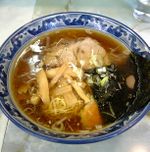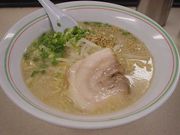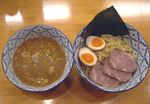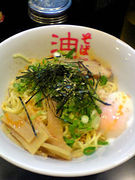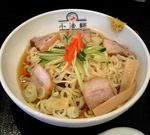Ramen
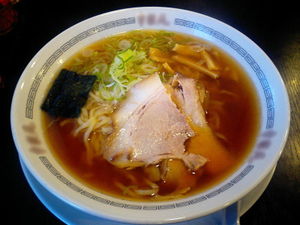
Ramen (ラーメン rāmen, IPA: [ɽaꜜːmeɴ] (![]() listen)) is a Japanese noodle dish that originated in China. It is served in a meat- or fish-based broth, often flavored with soy sauce or miso, and uses toppings such as sliced pork (チャーシュー chāshū), dried seaweed (海苔 nori), kamaboko, green onions, and occasionally corn. Almost every locality in Japan has its own variation of ramen, from the tonkotsu (pork bone broth) ramen of Kyūshū to the miso ramen of Hokkaidō.
listen)) is a Japanese noodle dish that originated in China. It is served in a meat- or fish-based broth, often flavored with soy sauce or miso, and uses toppings such as sliced pork (チャーシュー chāshū), dried seaweed (海苔 nori), kamaboko, green onions, and occasionally corn. Almost every locality in Japan has its own variation of ramen, from the tonkotsu (pork bone broth) ramen of Kyūshū to the miso ramen of Hokkaidō.
Contents |
History
Though of Chinese origin, it is unclear when ramen was introduced to Japan. Even the etymology of the word ramen is a topic of debate. One hypothesis is that ramen is the Japanese pronunciation of the Chinese: 拉麺 (la mian), meaning "hand-pulled noodles." A second hypothesis proposes 老麺 (laomian, "old noodles") as the original form, while another states that ramen was initially 鹵麺 (lǔmiàn), noodles cooked in a thick, starchy sauce. A fourth hypothesis is 撈麵 (lāomiàn, "lo mein"): 撈 means to "dredge up" and refers to the method of cooking these noodles by immersing them in boiling water before dredging them up with a wire basket.
Until the 1950s, ramen was called shina soba (支那そば, literally "Chinese soba") but today chūka soba (中華そば, also meaning "Chinese soba") is more common. By 1900, restaurants serving Chinese cuisine from Canton and Shanghai offered a simple ramen dish of noodles (cut rather than hand pulled), a few toppings, and a broth flavored with salt and pork bones. Many Chinese also pulled portable food stalls, selling ramen and gyōza dumplings to workers. By the mid 1900s, these stalls used a type of a musical horn called a charumera (チャルメラ, from the Portuguese charamela) to advertise their presence, a practice some vendors still retain via a loudspeaker and a looped recording. By the early Shōwa period, ramen had become a popular dish when eating out.
After World War II, cheap flour imported from the U.S. swept the Japanese market. At the same time, millions of Japanese troops had returned from China and continental East Asia. Many of these returnees had become familiar with Chinese cuisine and subsequently set up Chinese restaurants across Japan. Eating ramen, while popular, was still a special occasion that required going out.
In 1958, instant noodles were invented by Momofuku Ando, the Taiwanese-Japanese founder and chairman of Nissin Foods. Named the greatest Japanese invention of the 20th century in a Japanese poll,[1] instant ramen allowed anyone to make this dish simply by adding boiling water.
Beginning in the 1980s, ramen became a Japanese cultural icon and was studied from many perspectives. At the same time, local varieties of ramen were hitting the national market and could even be ordered by their regional names. A ramen museum opened in Yokohama in 1994.[2]
Types
A wide variety of ramen exists in Japan, with geographical and vendor-specific differences even in varieties that share the same name. Ramen can be broadly categorized by its two main ingredients: noodles and broth.
Noodles
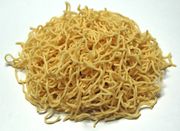
Most noodles are made from four basic ingredients: wheat flour, salt, water, and kansui, which is essentially a type of alkaline mineral water, containing sodium carbonate and usually potassium carbonate, as well as sometimes a small amount of phosphoric acid. Originally, kansui was named after the water from Inner Mongolia's Lake Kan which contained large amounts of these minerals and was said to be perfect for making these noodles. Making noodles with kansui lends them a yellowish hue as well as a firm texture. For a brief time after World War II, low-quality tainted kansui was sold, though kansui is now manufactured according to JAS standards. Eggs may also be substituted for kansui. Some noodles are made with neither eggs nor kansui and should only be used for yakisoba.
Ramen noodles come in various shapes and lengths. They may be fat, thin, or even ribbon-like, as well as straight or wrinkled.
Soup
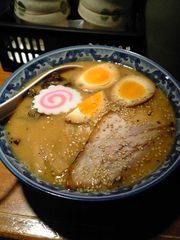
Ramen soup is generally made from stock based on chicken or pork, combined with a variety of ingredients such as kombu (kelp), katsuobushi (skipjack tuna flakes), niboshi (dried baby sardines), beef bones, shiitake, and onions, and then flavored with salt, miso, or soy sauce. Other styles that have emerged later on include curry ramen and other flavors.
The resulting combination is generally divided into four categories (although new and original variations often make this categorisation less clear-cut):
- Shio ("salt") ramen is probably the oldest of the four and, like the Chinese maotang (毛湯). It is the lightest ramen, a pale, clear, yellowish broth made with plenty of salt and any combination of chicken, vegetables, fish, and seaweed. Occasionally pork bones are also used, but they are not boiled as long as they are for tonkotsu ramen, so the soup remains light and clear. Shio is generally the healthiest kind of ramen; fat content tends to be low, and fresh vegetables like cabbage, leeks, onions, and bamboo shoots typically adorn the simple soup and curly noodles. Chāshū is sometimes swapped out for lean chicken meatballs, and pickled plums and kamaboko are popular toppings as well. Noodle texture and thickness varies among shio ramen, but they are usually straight rather than curly.
- Tonkotsu ("pork bone") ramen usually has a cloudy white colored broth. It is similar to the Chinese baitang (白湯) and has a thick broth made from boiling pork bones, fat, and collagen over high heat for many hours, which suffuses the broth with a hearty pork flavor and a creamy consistency that rivals milk or melted butter or gravy (depending on the shop). Most shops, but not all, blend this pork broth with a small amount of chicken and vegetable stock and/or soy sauce. Currently the latest trend in tonkotsu toppings is māyu (マー油/麻油), a blackish, aromatic oil made from either charred crushed garlic or Sesame seeds. The noodles are thin and straight. It is a specialty of Kyūshū and is often served with beni shoga (pickled ginger).
- Shōyu ramen typically has a brown and clear color broth, based on a chicken and vegetable (or sometimes fish or beef) stock with plenty of soy sauce added resulting in a soup that’s tangy, salty, and savory yet still fairly light on the palate. Shōyu ramen usually has curly noodles rather than straight ones, but this is not always the case. It is often adorned with marinated bamboo shoots or menma (麺媽), green onions, kamaboko (fish cakes), nori (seaweed), boiled eggs, bean sprouts and/or black pepper; occasionally the soup will also contain chili oil or Chinese spices, and some shops serve sliced beef instead of the usual chāshū.
- Miso ramen is a relative newcomer, having reached national prominence around 1965. This uniquely Japanese ramen, which was developed in Hokkaidō, features a broth that combines copious amounts of miso and is blended with oily chicken or fish broth – and sometimes with tonkotsu or lard – to create a thick, nutty, slightly sweet and very hearty soup. Miso ramen broth tends to have a robust, tangy flavor, so it stands up to a variety flavorful toppings: spicy bean paste or tōbanjan (豆瓣醤), butter and corn, leeks, onions, bean sprouts, ground pork, cabbage, sesame seeds, white pepper, and chopped garlic are common. The noodles are typically thick, curly, and slightly chewy.
Seasonings commonly added to ramen are black pepper, butter, chili pepper, sesame seeds, and crushed garlic. Soup recipes and methods of preparation tend to be closely guarded secrets.
Some restaurants also offer a system known as kae-dama (替え玉), where customers who have finished their noodles can request a "refill" (for a few hundred yen more) to be put into their remaining soup.
Regional variations
While standard versions of ramen are available throughout Japan since the Taisho era, the last few decades have shown a proliferation of regional variations. Some of these which have gone on to national prominence are:
Sapporo, from the capital of Hokkaidō, is especially famous for its ramen. Most people in Japan associate Sapporo with its rich miso ramen, which was invented there and which is ideal for Hokkaidō's harsh, snowy winters. Sapporo miso ramen is typically topped with sweetcorn, butter, bean sprouts, finely chopped pork, and garlic, and sometimes local seafood such as scallop, squid, and crab. Hakodate,[3] another city of Hokkaidō, is famous for its salt flavored ramen, while Asahikawa,[4] in the north of the island, offers soy sauce flavored ones.
Kitakata in northern Honshū is known for its rather thick, flat, curly noodles served in a pork-and-niboshi broth. The area within its former city boundaries has the highest per-capita number of ramen establishments. Ramen has such prominence in the region that locally, the word soba usually refers to ramen, and not to actual soba which is referred to as nihon soba ("Japanese soba").
Tokyo style ramen consists of slightly thin, curly noodles served in a soy-flavoured chicken broth. The broth typically has a touch of dashi, as old ramen establishments in Tokyo often originate from soba eateries. Standard toppings on top are chopped scallion, menma, sliced pork, kamaboko, egg, nori, and spinach. Ikebukuro, Ogikubo and Ebisu are three areas in Tokyo known for their ramen.
Yokohama ramen specialty is called Ie-kei (家系). It consists of thick, straight-ish noodles served in a soy flavored pork broth similar to tonkotsu. The standard toppings are roasted pork (char siu), boiled spinach, sheets of nori, with often shredded leak (negi) and a soft or hard boiled egg. It is traditional for customers to call the softness of the noodles, the richness of the broth and the amount of oil they want.
Wakayama ramen is a tonkotsu shôyû (pork bone and soy sauce) soup that marks the symbolic middle point between thin soy Tokyo-style ramen and thick porky Kyushu ramen; Thick, strong, and porky for sure, it also packs a strong shōyu taste. Like Tokyo ramen, there's a little slice of pink and white fishcake, but like Hakata ramen, the noodles are thin, white, straight, and firm. It's nearly identical to its cross-strait cousin Tokushima ramen; Tokushima ramen places higher importance on a raw egg in the soup and has slightly thicker noodles, but the two are practically the same. (copied from [1])
Hakata ramen originates from Hakata district of Fukuoka city in Kyūshū. It has a rich, milky, pork-bone tonkotsu broth and rather thin, non-curly and resilient noodles. Often, distinctive toppings such as beni shoga (pickled ginger), sesame seeds, and pickled greens are left on tables for customers to serve themselves. Ramen stalls in Hakata and Tenjin are well-known within Japan. Recent ramen trends have made Hakata ramen one of the most popular types of ramen in Japan, and these days several chain restaurants specializing in Hakata ramen can be found all over the country.
Kumamoto style ramen soup is a tonkotsu based, white colored broth, but where it differs from Hakata style ramen is its milder flavor. Kumamoto style ramen is also often flavored with fried garlic oil that is noticeable with the brown oil. The noodles are often thicker than the Hakata style, and includes unique toppings such as kikurage mushrooms, and lightly cooked or raw cabbage. (copied from [2])
|
Related dishes
There are a number of related, Chinese-influenced noodle dishes in Japan. The following are often served alongside ramen in ramen establishments. They do not include noodle dishes considered traditionally Japanese, such as soba or udon, which are almost never served in the same establishments as ramen.
- Nagasaki champon. Champon is topped with a variety of ingredients, mostly seafood, stir-fried and dressed in a starchy sauce. The stir-fried ingredients are poured directly over the cooked noodles without soup.
- Tan-men is a mild, usually salt tasted soup, served with a mix of sauteed vegetables and seafood. Not to be confused with the tantan-men (see after).
- Wantan-men has long straight noodles and wonton, served in a mild, usually salt tasted soup.
- Abura soba ("oil-noodles"). Essentially ramen and toppings served without the soup, but with a small quantity of oily soy-based sauce instead.
- Tsuke-men ("dipping noodles"). The noodles and soup are served in separate bowls. The diner dips the noodles in the soup before eating. Can be served hot or chilled.
- Tantan-men (担担麺). Japanese version of dan dan noodles, a Sichuan specialty. Ramen in a reddish, spicy chilli and sesame soup, usually containing minced pork, garnished with chopped scallion and chili and occasionally topped with the likes of spinach or Chinese cabbage (chingensai).
- Sanratanmen is very similar to Sichuan hot and sour soup served with long noodles. The topping ingredients are sauteed and a thickener is added, before the mix is poured on the soup and the noodles.
- Hiyashi-chūka (冷やし中華, "chilled Chinese"). Also known as reimen, esp. in western Japan. A summer dish of chilled ramen on a plate with various toppings (typically thin strips of omelette, ham, cucumber and tomato) and served with a vinegary soy dressing and karashi (Japanese mustard). It was first produced at the Ryutei, a Chinese restaurant in Sendai.
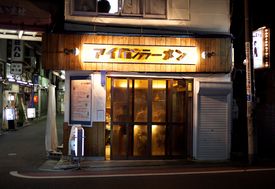
Restaurants in Japan
Varieties of restaurants like izakaya drinking establishments, karaoke halls, and amusement parks offer ramen - but the best quality ramen is usually only available in ramen-ya restaurants. These restaurants generally boast of 10 to 20 seats at a bar and three or four tables.
The menus in ramen-ya restaurants offer mainly ramen dishes, so they lack much variety. Besides ramen, some of the dishes generally available in a ramen-ya restaurant include fried rice (called Chahan or Yakimeshi), Gyōza (Chinese dumplings), and beer.
Outside Japan
-
- For Instant ramen outside Japan, see Instant noodles worldwide.
Ramen has become popular in China in recent years where it is known as rìshì lāmiàn (日式拉面, "Japanese Style lamian"). Popular Japanese ramen chains serve ramen alongside distinctly Japanese dishes such as tempura and yakitori, something which would be seen as odd in Japan.
Wagamama, a successful pan-Asian chain with establishments mainly in European cities, is known for its noodle soups marketed as ramen (but which are quite different from ramen in Japan).
Ramyeon (라면) is the Korean version of ramen. Ramyeon in Korea is a popular instant meal. Korean ramyeon is known to be hot and spicy, as its soup is usually flavored with chili peppers. There are many varieties of Korean ramyeon, such as kimchi-flavored, seafood-flavored and beef-flavored. Some restaurants serve variations of ramyon with different flavors.[5] It is usually served with vegetables, such as carrots and green onions, and eggs on top.
In Central Asia the dish has thicker noodles, is significantly spicier, and is known as laghman.
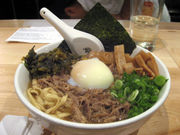
In North America, Japanese instant noodles were imported starting in the 1970s bearing the name "ramen." And so the term ramen is often used in North America to refer to instant noodles. Many restaurants now exist, however, that specialize in Japanese-style ramen, especially in California, and also in urban areas with large demand for Asian cuisine, such as Vancouver, Toronto, Chicago, New York, Houston, and Seattle.
Health concerns
A serving of ramen is high in carbohydrates and low in vitamins and minerals. Ramen soup tends to be high in sodium. Ramen noodles themselves contain very little sodium so one can avoid drinking the soup if a low-sodium diet is recommended for health reasons.
Many Japanese people also believe that ramen soup contains a high amount of fat and also that pre-fried fat from the noodles seeps into the soup.
Museum

The "Shin-Yokohama Raumen Museum" is a unique museum about ramen. In a gallery on the first floor, the museum presents the history of ramen in Japan, including the big success of instant ramen. It displays the variety of noodles, soups, toppings and bowls used across Japan, and shows how the noodles are made. On the two basement floors, visitors can explore a 1:1 replica of some streets and houses of Shitamachi, the old town of Tokyo, circa 1958, when the popularity of ramen was rapidly increasing. Nine ramen restaurants can be found there, each featuring a ramen dish from a different region of Japan. For visitors who wish to try multiple ramen dishes, the restaurants offer "mini ramen" small portions. Tickets for the meals are purchased at vending machines in front of each restaurant before entering.[6]
Canned version
In Akihabara, vending machines distribute warm ramen in an aluminum can. Known as らーめん缶 (ramen can), it is gaining public attention. It is produced by a popular Ramen restaurant and contains noodles, soup, menma, and pork. It is intended as a quick snack, and includes a small folded plastic fork. There are few kinds of flavor such as tonkotsu and curry.[7]
See also
- Instant noodles
- Noodle soup
- Shin-Yokohama Raumen Museum
- Lamian
- Lo mein
- Dan dan noodles
- Japanese cuisine
- Udon
- Soba
- Hawaiian saimin
- Yakisoba
- Shirataki noodles
- Kagoshima ramen
Notes
- ↑ "Japan votes noodle the tops". BBC News. 2000-12-12. http://news.bbc.co.uk/1/hi/world/asia-pacific/1067506.stm. Retrieved 2007-04-25. BBC News
- ↑ Japanorama, Series 3, Episode 4. BBC Three, 9 April 2007
- ↑ http://www.ramenate.com/2009/12/hakodate-ramen-daimon.html
- ↑ http://www.asahikawa-tourism.com/asahikawa/asahikawa.../asahikawa_ramen/asahikawa_ramen.html
- ↑ Back to Korean-Style Ramyeon at Nenassi's Noodle Bar
- ↑ "Ramen Museum". http://www.japan-guide.com/e/e3202.html. Retrieved 2008-06-18.
- ↑ "Ramen-can:a topic in Akihabara". http://www.globalpopculture.info/archives/159. Retrieved 2008-02-13.Global Pop Culture
